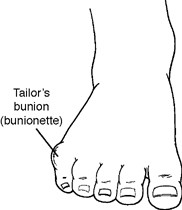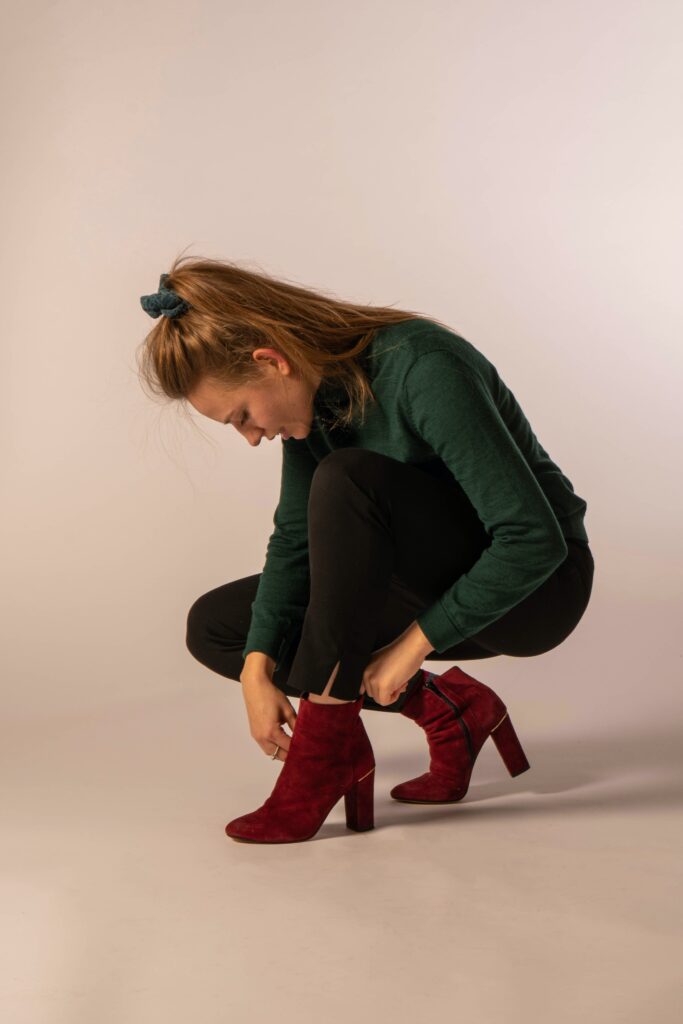What is a Tailor’s Bunion or Bunionette?
You’ve probably heard about bunions. Since an estimated 30% of Americans have had a bunion at some point, you probably know someone who’s had a bunion! But have you ever heard of the less common tailor’s bunion?
While regular bunions usually affect the big toe, a tailor’s bunion, or a bunionette, affects the fifth metatarsal or little toe.
Don’t let the cute name fool you. Bunionettes can become quite painful and problematic. They can also impact your ability to wear your favorite pair of shoes.

Where Did the Tailor’s Bunion Get Its Name?
This deformity got its name hundreds of years ago when tailors often sat cross-legged on the floor all day to work. In this position, the outside edge of their feet rubbed on the ground. That friction eventually led to a painful bunionette at the base of their little toe.
What Causes a Tailor’s Bunion?
Tailor’s bunions are often caused by wearing shoes that are too narrow across the toes. High heels and pointed-toe shoes are the worst culprits in this area. They usually leave even less room for your toes than your typical shoes. This causes rubbing and pressure that over time can result in a bunionette. The bone will bow outward, which creates a bony bulge on the outside edge of your foot. This typically occurs where your pinky toe meets your foot.
Did you know you can be genetically predisposed to bunions? Genetics can also play a role in whether you develop not just a bunionette but your typical bunion as well, regardless of what types of shoes you wear. Thanks, mom and dad!
Other Causes of a Tailor’s Bunion Include:
- A protruding fifth metatarsal bone which causes the little toe to move inward
- Bone growth (bony spur) on the side of the fifth metatarsal
- Arthritis
- An inverted foot which causes you to walk with your feet leaning out.
- Loose ligaments in your foot – also called a splayed foot
- Tight calf muscles that can impact how you stand or walk
If the tailor’s bunion becomes severe enough, you may notice your little toe starts to turn in towards your other toes. Over time, your bunionette may get to the point where you’ll have a toe growing over or under your other toes. This deformity can affect how you stand and walk.

Common Signs and Symptoms of Bunionettes
Tailor’s bunions are characterized by a bump on the outside edge of the little toe. The size of the bunionette can vary. They may start small and then increase in size over time.
Other signs of a tailor’s bunion include:
- Red, swollen, and/or a callus on the outer edge of your pinky toe
- Pain and burning over the site of the enlargement
- Pain worsens over the course of the day, but this pain does not radiate to other parts of your foot.
- Narrow or pointy-toed shoes make pain worse
- Being barefoot usually relieves pain
What Can I Do About My Tailor’s Bunion?
Diagnosing a tailor’s bunion is usually a straightforward process. Typically, the bunionette is easy to spot by both you and your doctor. Your podiatrist may also use X-rays to view the extent of the deformity and to see if there are any additional problems with the bones of the little toe.
While a tailor’s bunion won’t usually pose any serious threats to your health, it may affect your quality of life. Pain is never something you have to live with.
If you’re dealing with a tailor’s bunion, there’s good news. Bunionettes can be easily addressed with both surgical and non-surgical treatments. Depending on the severity of your tailor’s bunion, conservative treatment options may alleviate your pain without the need for surgery.

Non-Surgical Treatments
- Wearing wider shoes that have plenty of room in the toe area so you’re not forcing your toes to crowd each other.
- Avoid wearing narrow, high-heeled, and pointed shoes.
- Padding the painful area with moleskin or a silicone pad may help relieve pressure and reduce rubbing against your shoes.
- Finding a way to reduce the callus (if present) may also give you relief.
- Custom orthotics can help depending on your specific foot type
- Stretches to release tight calf muscles
- Icing the bunion can reduce pain and inflammation. To avoid skin damage, avoid applying ice directly to the skin.
- Pain and inflammation can sometimes be managed by over-the-counter (OTC) non-steroidal anti-inflammatory drugs (NSAIDs) like ibuprofen. These types of medications can help lessen your symptoms and swelling.
When Is Surgery Needed?
Your podiatrist may recommend surgery when conservative non-surgical treatments are not providing you relief from your symptoms or your tailor’s bunion becomes so large that you’re unable to wear most shoes.
You’ll be happy to know that surgical options for your tailor’s bunion are usually straightforward and have a good success rate.
Your surgical options will vary depending on the severity of your bunionette. Surgery may be as simple as shaving off a small portion of the growth that is causing your pain. Or it can be more complicated and involve the realignment of muscles, ligaments, and tendons that have shifted because of the bunionette. Sometimes this means the bones themselves need to be shifted and moved so they can be realigned with a pin or screw to hold them in the corrected position as the bone heals.
Your recovery time will depend on which surgical procedure, or combination of procedures, you and your podiatrist agree upon.
Why Choose a Foot and Ankle Surgeon?
Foot and ankle surgeons are the leading experts in foot and ankle care. Each of our podiatrists at Western Montana Foot and Ankle are doctors of podiatric medicine and are board-certified surgical specialists. They have more education and specialized training that focuses only on the foot and ankle than any other healthcare provider.
If you or someone you know has a bunionette or tailor’s bunion that is affecting their quality of life, don’t hesitate to reach out to one of our foot and ankle surgeons here at Western Montana Foot and Ankle. We are privileged to serve our patients and look forward to getting you back on your feet and enjoying everything Western Montana has to offer.
